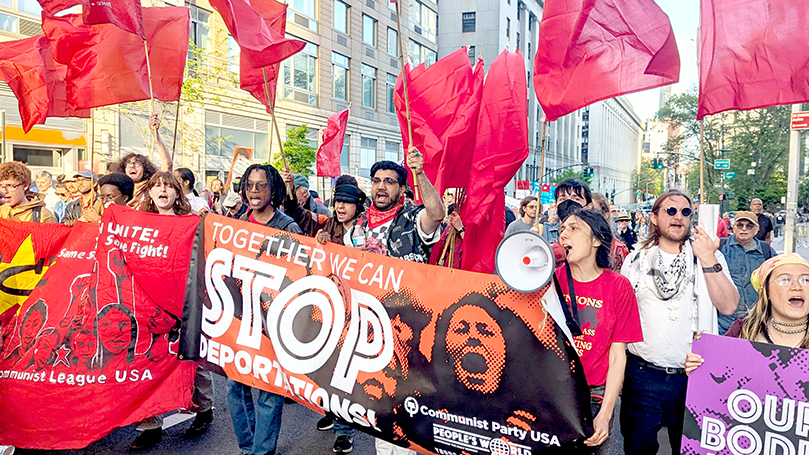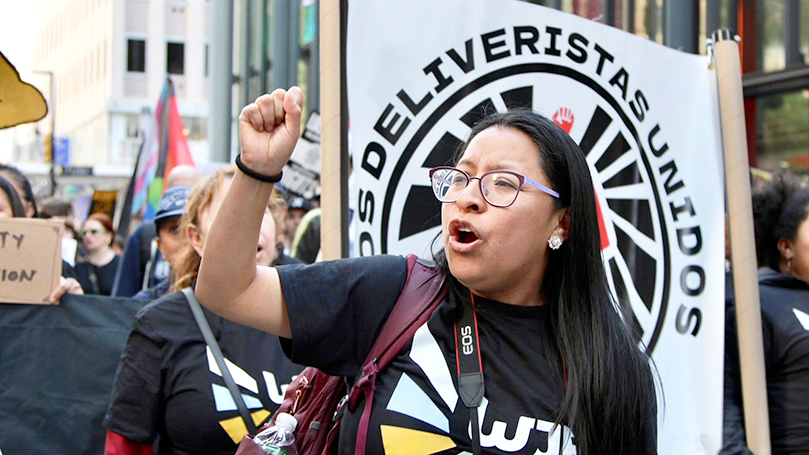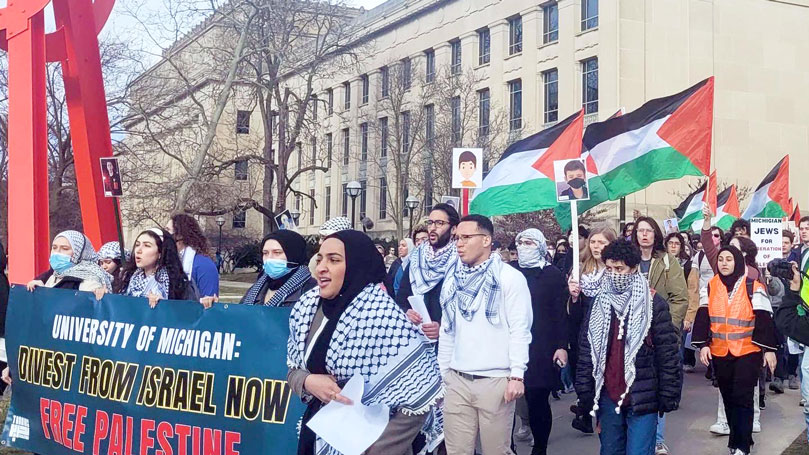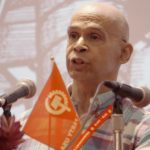
Keynote given by party co-chair Joe Sims to the CPUSA National Committee July 13, 2025. More NC reports here.
Our National Committee is meeting today in a political climate that is very different from when we gathered in February – and that’s good news. Back then, if you recall, the anti-MAGA movement had not yet recovered from the shock of the GOP victory.
Today, however, it’s clear that the resistance is back and it’s back in a big way. The resurgence of a broad, spirited, democratic opposition to the Trump Agenda is arguably the most important development of the last several months.
Resistance finds its footing
What began somewhat tentatively in the winter with scattered protests and spontaneous boycotts blossomed in the spring into a full-blooded national protest movement. Here, the April 5th “Hands Off” demonstrations, along with AOC’s and Bernie’s Oligarchy Tours, stand out. So too with May Day around the country. In fact, the May Day initiatives of local unions and central labor bodies, along with the immigrant rights movement, were particularly important. The protests were big, militant, and unifying. They showed what was possible in terms of building the unity, breadth, and diversity of the people’s front.
And what was possible took a huge leap forward in the June 14th No Kings Day actions that brought several million into the streets denouncing the DOGE cuts, the arrests and deportations, and the growing lawlessness of the Trump Administration.
The youth vote for Mamdani marked a shift from the politics of protest to the protest of politics as defined by Wall Street. It should make everyone sit up.
Then came a political earthquake in New York City when voters chose by double digits the democratic socialist Mamdani as their candidate for Mayor. It was a campaign about affordability, dignity, and diversity. Its success marked a shift, particularly among young voters, from the politics of protest to the protest of politics as defined by Wall Street and the political establishment. This is a shift that should make everyone sit up and pay attention. As the November election approaches, and the midterms inch closer, tactical questions are front and center. Will corporate Democrats follow their now standard script of spurning the left to woo the center, or will they choose to build on the energy and excitement generated by the Mamdani campaign? On the other hand, will the campaign manage to keep its head and resist provocations and splits in what’s sure to be an all-out attempt to defeat it?
Multi-racial, working-class unity
But in N.Y. not only is left-center unity at stake — multi-racial unity is too. Expanding the campaign’s already ethnically diverse base to increase support among African Americans in particular will be essential to creating a coalition capable of winning. The recent endorsement of NYC’s Central Labor Council should help as unions enjoy high membership and support among people of color.
In fact, for reasons of composition alone, involving the labor movement nationally is key to addressing some of Resistance 2.0’s weaknesses. For example, attendance at the spring protests was overwhelmingly white. There were important exceptions, however, including a March anti-DOGE protest in New York City and May Day events around the country. The March action was organized by the Working Families Party and Make the Road. A labor–community coalition made it happen. The May Day events were diverse not only because of who makes up our unions but also because of their fighting stance on issues that affect their membership — from DEI and healthcare to deportation. In other words, people had a reason to turn out. That should be instructive. The only question is, will the anti-MAGA movement draw the lesson?

Of course, there’s no substitute for involving folks on the ground floor. This was a major weakness of recent anti-MAGA initiatives, no matter the reason. It helped exacerbate perceived slights and fed efforts to widen divides. Attempts to correct this error by invitations to a table that has already been set, are, to say the least, wanting. The upcoming July 17th Make Good Trouble protests and the August 28th March on Wall Street in support of DEI present opportunities to move forward. As we’ve emphasized before, no movement for democracy in the U.S. has any chance of success without the central participation of people of color, African Americans in particular.
March on Washington
The recent resolution by the Coalition of Black Trade Unionists urging the AFL-CIO to call a national Union Day of Solidarity rally in Washington D.C. should be seen in this context. Not only are Black, Latino, and Asian workers disproportionately affected by the DOGE cuts, they are also the main targets of the recently passed MAGA bill. Their families and communities will be most affected by the deportations, the cutbacks to Medicaid, food stamps, and other programs. CBTU’s appeal to the AFL-CIO, therefore, should be understood as an urgent call to our white union siblings for solidarity in defense of common interests. How and when will labor respond?
Labor is the only force in the country that can speak to the ruling class in the language it understands: the language of power.
And it’s critical that labor responds. It is the only force in the country that can speak to the ruling class in the one true language it understands: the language of power. The fact of the matter is that the growing protest movement, despite all the demonstrations and lawsuits, has yet to slow the Trump offensive. And one of the big reasons is that labor’s presence has not been felt widely and forcefully enough — it has yet to “talk that class struggle talk” to the bosses.
And now, one of the few remaining checks on bosses’ lawlessness has been upended by the Supreme Court. District courts have been all but stripped of authority to issue injunctions that block executive orders nationwide. With the nation’s highest court and Congress now aligned with the Oval Office’s power grabs, the space for pushback has grown increasingly narrow. Is now not the time for labor in coalition with its allies to take a demonstrable stand? This is precisely why a national march on Washington grows in importance with the passing of each day.
Such a march could be a platform for saying, “Hell no!” More than that, it could be an organizing occasion for the upcoming midterm elections. Coalitions brought together to attend, after returning home, could continue the hard work of preparing to contest the elections. Imagine local unions, community groups, the religious community, civil rights, LGBTQ, youth and students, the senior citizens, the disabled, the unaffiliated and unregistered, local business, uniting to kick the GOP out of the House and Senate.
These independent political forces could work with Democrats, Working Families Party, and others to find candidates, register voters, and turn out the vote. By “independent political forces,” we’re talking about trade unions and other organizations that operate outside of the Democratic National Committee and have their own election infrastructure. Unions have an independent candidate selection process, fundraising structures, mailing lists, media, and get-out-the-vote operations. Organizing efforts could prioritize working alongside them and others to maximize collective impact.

Communist candidates
Putting forward our own candidates must be part of these efforts. For far too long, the party’s electoral work has — albeit with some districts’ exceptions — consisted in coalescing every election cycle with the broader democratic movement to defeat far-right candidates, but without running for office ourselves. What began in the 1980s as an absolutely correct tactical adjustment became a permanent, now decades-long policy. In practice, it amounted to sacrificing our existence as an independent electoral force and minimized our posture as a working-class, revolutionary political party. This self-defeating policy must end.
While it remains essential to defeat far-right candidates and work within broad united front efforts, this cannot come at the expense of shutting ourselves down completely or even supporting other left candidacies at times. Nor should we pursue strategies that risk helping MAGA Republicans. Our primary objectives must always guide our electoral tactics, but part of our primary objective must be to build the party.
A national electoral conference should prepare us to take on MAGA forces and to run ourselves. And we have several candidates who are preparing to do just that.
Of course, in many aspects of party activity, we’re building from the ground up and the electoral arena is no exception. Standing for elections must become a basic feature of our rebuilding process. Beginning at the local level, we must become experts in all aspects of electoral politics, including election law, campaign financing, canvassing, use of voter registration lists, advertising, developing a platform, and more. With this in mind, let’s consider holding a national electoral conference early next year. As with many things in life, the most important thing at the beginning of any collective process is the first step. The first step should prepare us to take on MAGA forces and to run ourselves. The good news here is that we have several candidates who are preparing to do just that. In fact, they have inspired me to consider running myself. And with the NC’s permission, I will consult with the N.Y. District about doing just that.
Navigating next year’s election terrain will be extremely complicated, but navigate it we must: everything depends on defeating the GOP in Congress. And as recent events suggest, they are vulnerable. There is fury at the grassroots over the mass firings, the union busting, the immigration round ups — along with the deployment of troops — and now the trillion dollar Medicaid cuts. On top of this, the MAGA regime is extremely unstable as the public disputes between different factions indicate with Elon Musk calling for the creation of a third party. But internal strife is also consuming the Democrats. Labor leaders have resigned from the DNC amidst huge leadership and policy disputes.
Imperialism on crack
There is also growing unrest over the Trump administration’s U.S. imperialism-on-crack international policy. Its claim to be an administration of peace, always laughable, disappeared with the bombing of Iran’s nuclear infrastructure, along with any hope they would back away from supporting the Gaza genocide and complete removal of the Palestenian population. But did anyone think in their wildest dreams that they’d start off by threatening to annex Canada and Greenland and occupy Panama in order to seize the canal? Clearly there’s a dangerous new aggressiveness in sections of the U.S. ruling class as it seeks to maintain its place as imperialism’s top dog in the face of competition from other imperialist countries in Europe and Asia. And this aggressiveness heightens the danger of direct conflict with China, Cuba, and other countries moving in a socialist direction.
Then, of course, there are the now on-again, now off-again tariffs which, if ever enacted, are sure to increase the cost of living to those who can least afford it. And once again, there are the bullying and threats against other countries, most recently directed at Brazil, who hosted the BRICS summit.

Needless to say, none of this bodes well. Small wonder public confidence in the two political parties, the courts, Congress, and the mass media continues to dwindle, as does hope among broad sections of the public. Prices remain high, wages remain stagnant, and the working class is not having it. Labor militancy remains high; and strike activity across the country, after having declined slightly last year, is back up. If current trends continue, the number of strikes might equal, if not exceed, levels reached during the pandemic.
Building our party and press
Yes, taken as a whole, there is a rising tide of struggle, and with it, opportunities for continuing to build a mass Communist Party and Young Communist League. Party growth, as measured by the circulation of our press and recruitment numbers, remains steady.
It is in the clubs that the party lives, breathes, and becomes a fighting force.
Importantly, we reached our spring People’s World fund drive goal and are now getting ready for the fall campaign. And most importantly, our clubs remain extremely active in the anti-MAGA fightback all across the country. What takes place in the clubs is the most important measure of all. It is there that the party lives, breathes, and becomes a fighting force.
Here we must take note of our initiative and participation in the Boycott Target campaign in D.C. and a number of other clubs around the country. What began spontaneously has taken on organized forms and has had a significant impact. Let’s keep the pressure on. Here we have 10,000 boycott Target cards ready to be distributed to help give an additional boost to our efforts.
With regard to boycotts, the party needs to add Home Depot to the list. So, too, with the BDS campaign. It must occupy a place at the top of our list. Palestinian solidarity must be stepped up and our upcoming conference in November must help ensure that this happens.
A list of priorities in the coming period should include:
- Continued presence in anti-MAGA protests and involvement in Rapid Response efforts;
- Participation in key events of labor and people’s movements, including those led by LACLAA, NAACP, Urban League, the Congressional Black Caucus, and the National Action Network’s March on Wall Street;
- Pushing for resolutions in support of a national march on D.C.;
- Target and Home Depot boycotts;
- Identifying key 2025 election campaigns, including our own;
- Palestine solidarity;
- Cuba solidarity;
- Completing the People’s World Fund drive.
At the same time, we must acknowledge that many of the problems we addressed at the convention remain in search of a solution: that includes consolidating club and district leadership collectives, local circulation of our press, completing fund raising goals and building the YCL. At the national level many areas of work remain unfulfilled for lack of having comrades willing and able to anchor them. And yet, we continue to search for solutions, understanding that they come with time and growth — and the important thing is that we’re growing.
The fascist danger
Comrades, the danger of fascism has increased dramatically. Our class and people are confronting the most dangerous administration in our history. Racism, antisemitism, Islamophobia, sexism, anti-immigrant, and anti-LGBTQ hate have increased dramatically. The big ugly bill recently signed into law has supercharged massive infusions of capital to target immigrants three times the amount allotted to the FBI. ICE enforcement expansions amount to tens of billions per year, with total earmarks around $170 billion over multiple years. In contrast, the FBI’s entire annual budget is approximately $11–11.3 billion. Talk about funding a police state!
But the people’s movement to preserve democracy is gathering in strength and its unity and potential power is something you can’t put a price on — and even if you could, you couldn’t buy it.
We enter the upcoming battles with that knowledge, buoyed by the joy and hope that comes with struggle.
Images: IUPAT members pose at the NYC May Day march against attacks on workers, immigrants, and communities by NYC Central Labor Council (Facebook); CPUSA and YCL members march on May Day; Deliveristas march at the NYC May Day march by NYC Central Labor Council (Facebook); University of Michigan students demand divestment from Israel (CPUSA Michigan)


 Join Now
Join Now